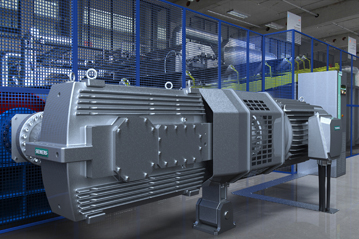The Siemens Drive Technologies Division will be presenting the “Integrated Drive System” (IDS) at Hannover Messe 2013, a whole new dimension in solutions for drive tasks: IDS integrates the Division’s uniquely complete product portfolio. IDS thus provides full and reliable integration of the drive train with different focuses for almost all industries. IDS covers all relevant drive technology performance classes and provides customers with a high level of productivity, efficiency, and reliability. Ralf-Michael Franke, CEO of Drive Technologies Division: “With the Integrated Drive System, we are writing a new chapter in the success story of drive systems from Siemens. We are providing our customers with a comprehensive range of possibilities for optimum use of the most all-embracing product portfolio for electric drives, which we have been innovating continuously for more than 160 years.”
In technological terms, the IDS concept is based on three-fold integration: Horizontal integration already optimally attunes the components required for the drive train to each other and for their intended task in the factory. This is done by drawing on the vast Siemens portfolio of gear units, couplings, motors, and converters, which can be combined to optimize dimensioning for the task at hand. For example, the fully integrated Simogear range of geared motors, with its compact design that is suitable for nearly all applications. But IDS also pays in the highest performance classes. At Hannover Messe, Siemens will be showing a complex drive train for vertical mills in the cement industry. Use of ideal combinations of Sinamics converters, Flender couplings, and Simotics motors achieves a very high level of productivity, energy efficiency, and reliability during operation.
Vertical integration, that is, integration of the drive train into the system architectures of the industrial production processes, is an essential precondition for production with maximum value added: IDS therefore uses the integration of the drive train and its components into the TIA architecture of Siemens Industry: All TIA components, from the sensor level to the manufacturing execution system, are attuned to each other and enable maximum communication and control. As part of its IDS presentation, Siemens is showcasing integration of the Sinamics G120 family into the TIA Portal and announces integration of the Simotion controllers into the TIA Portal.
Life cycle integration is the third dimension of IDS. Siemens is offering comprehensive solutions throughout the factory automation or process automation life cycle. At every stage, from design to planning, engineering, commissioning, and operation, and to modern industry services, considerable optimization potential can be leveraged. This includes not only integration of the drive train components into the TIA Portal, but also software products such as Sinasave for evaluating the most energyefficient drive solution or the DT Configurator for fast selection of suitable products for a customized drive train.
The system of three-fold integration has a number of advantages for the customers of the Siemens Drive Technologies Division: The unique portfolio from a single source ensures compatibility and therefore simplified engineering, leaner commissioning, and increased reliability of the entire system. Vertical integration additionally provides a high level of monitoring, precise control, and therefore efficient use of energy, resources, and raw materials. Integration of the drive technology into the TIA Portal drastically simplifies engineering, commissioning, and diagnostics work. Configuration during the planning phase, the associated simulation, and drive train dimensioning, including seamless data management as part of the PLM engineering continuing up to operation provide a whole new dimension in efficiency and reliability.
Ralf-Michael Franke: “With Integrated Drive Systems, we are shortening our customers’ path to lasting economic success. We are proving that solutions for drive tasks are about more than just product features or the procurement costs for the drive components. Integrated Drive Systems ensure high availability of the application, investment protection through the use of future-oriented technologies, and finally reduced life cycle costs for all performance classes.”

